

Inoculation of Legumes for Maximum Nitrogen Fixation — Crops and Soils. Inoculant is Species Specific Legumes have the ability to form a mutually beneficial (symbiotic) relationship with certain soil bacteria of the type or genus Rhizobia.
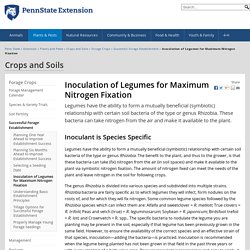
The benefit to the plant, and thus to the grower, is that these bacteria can take (fix) nitrogen from the air (in soil spaces) and make it available to the plant via symbiotic nitrogen fixation. The amount of nitrogen fixed can meet the needs of the plant and leave nitrogen in the soil for following crops. The genus Rhizobia is divided into various species and subdivided into multiple strains.
Rhizobia bacteria are fairly specific as to which legumes they will infect, form nodules on the roots of, and for which they will fix nitrogen. Inoculation Techniques Inoculum is not magic dust - it contains bacteria that must be kept alive. Live bacteria may be added to the soil (direct-soil application) or to the seed (seed-applied inoculant). Direct-soil Application. Infographic: Pick Your Predator Patrol.
Advanced Cell Grazing - Permaculture Livestock Systems at Zaytuna Farm. Details - Important western browse plants / Title Important western browse plants / Related Titles Related/Analytical: Browse plants.

Series: Miscellaneous publication / United States Department of Agriculture ; no. 101 By Dayton, William A. Livestock Guardian Dogs Protect a Kansas Flock. After 10 years of relatively calm, successful lambing seasons, last year brought calamity to our Kansas farm, Rancho Cappuccino, in the form of the coyote.

For a decade, we had tolerated the occasional loss of a small or weak lamb, figuring that the coyotes were here first and that they had a right to make their living off the land as well. A year ago, however, they started hunting in a pack, digging large holes under our fences faster than we could block them, and picking off our lambs at a ferocious rate. We lost 40 percent of them (about 2 dozen lambs), and the predation continued for months. The Beginning Farmer’s Guide To Animal Nutrition. Tambako The Jaguar/Flickr Nothing is more important to your farm than your animals’ nutrition, regardless of whether they are cattle, chickens or pigs.
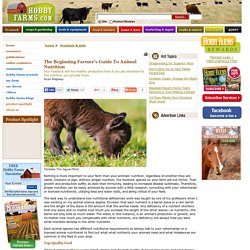
Without proper nutrition, the livestock species on your farm will not thrive: Their growth and production suffer, as does their immunity, leading to increased disease outbreaks. Thankfully, proper nutrition can be easily achieved by anyone with a little research, consulting with your veterinarian or licensed nutritionist, utilizing feed and water tests, and being critical of your feed. The best way to understand how nutritional deficiencies work was taught by one of my professors when I was working on my animal science degree. Envision that each nutrient is a barrel stave in a rain barrel and the length of the stave is the amount that the animal needs.
Growing your own hay. The time to reseed!
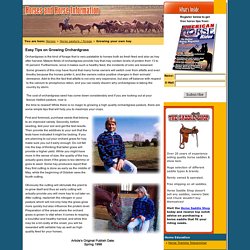
While there is no magic to growing a high quality orchardgrass pasture, there are some simple tips that will help you to maximize your crops. First and foremost, purchase seeds that belong to an improved variety. Equine Benefits - Fodder Systems - Healthy, fresh feed every day. FodderPro Feed Systems allow anyone to produce their own top-quality horse feed for just pennies a pound.
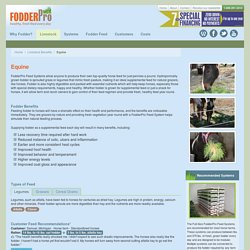
Hydroponically grown fodder is sprouted grass or legumes that mimic fresh pasture, making it an ideal supplemental feed for natural grazers, like horses. Fodder is also highly digestible and packed with essential nutrients which will help keep horses, especially those with special dietary requirements, happy and healthy. Whether fodder is grown for supplemental feed or just a snack for horses, it will allow farm and ranch owners to gain control of their feed regimen and provide fresh, healthy feed year round.
Feeding fodder to horses will have a dramatic effect on their health and performance, and the benefits are noticeable immediately. 5 Acres & A Dream: More Thoughts on Growing Animal Feeds. On the heels of ordering spring garden seeds, I'm thinking not only what to plant for us, but what to plant for our critters as well.
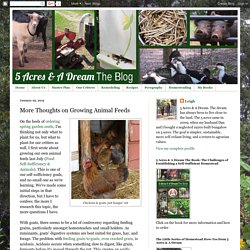
I first wrote about growing our own animal feeds last July (Food Self-Sufficiency & Animals). This is one of our self-sufficiency goals, and no small one as we're learning. We've made some initial steps in that direction, but I have to confess; the more I research this topic, the more questions I have. Feeding Rabbits: Making Hay for the Hutch - Animals. Feeding rabbits is a hot topic among enthusiasts, but the one thing most rabbit-rearing folks agree on is that the loppers should have ad-lib access to hay.
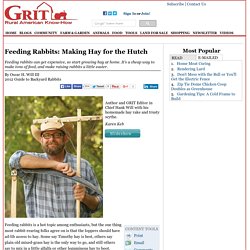
Some say Timothy hay is best, others say plain old mixed-grass hay is the only way to go, and still others say to mix in a little alfalfa or other leguminous hay to boot. Either way, between the eating and the pulling of hay from the feeders for bedding, at the end of the year, you could be looking at up to 100 pounds of hay per rabbit (enthusiasts heatedly disagree on just how much hay an individual rabbit will need). While many folks rush off to the pet store to source miniature hay bales for big bucks, others source it more reasonably in 70-pound bales right from the farm. HeartsEase Icelandic Sheep. All Hay Is Not Equal: Choose Your Livestock’s Carefully. During the cold winter months when pastures contain scant forage, hay is the typical diet for cattle, horses, sheep and goats.

Next to pasture, good quality hay is the ideal feed. However, there are significant differences in the variety, quality and availability of hay, which can make feeding your livestock a time-consuming chore. But with some planning, feeding hay during the winter months can be a simple and efficient alternative while waiting the return of spring's lush pastures. Hay falls into several categories: grass, legume, mixed (grass and legume) and cereal grain straw (such as oat hay). Some of the more common grass hays include timothy, brome, orchard grass and bluegrass. White Snakeroot and Goats - Goat Haute Adventures Blog.
During my years of wishing for a simpler life, I romanticized some aspects of country living.
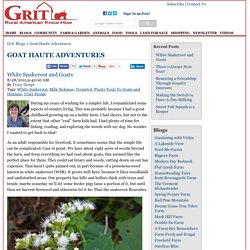
This was probably because I had a great childhood growing up on a hobby farm. I had chores, but not to the extent that other “real” farm kids had. Minnesota growers call cover crops ‘amazing’ Southwestern Minnesota farmer Jerry Ackermann is pretty impressed by what he’s learned from using cover crops during the past five years. He hopes to learn even more in the next three years by using a relatively new kind of soil test – known as a Haney soil test – to see what kind of nutrients are in his soils.
Jerry and Nancy Ackermann grow 1,200 acres of corn, soybeans and alfalfa in Jackson County, Minn. They’ve gradually been adding to their number of cover-crop acres. This is the first year all acres will have a cover crop. Erosion Control Crops. Organic Farming, Remediation of Soil Pollutants. Maharishi University of Management. Dairy sheep production research at the University of Wisconsin-Madison, USA ¿ a review. The Spooner Agricultural Research Station is the site of the only dairy sheep research flock in North America. The station is located in northwestern Wisconsin (N 45.8, W 91.9) and is the oldest of the 12 research stations operated throughout Wisconsin by the College of Agricultural and Life Sciences of the University of Wisconsin-Madison.
The station was established in 1909 with a donation of 32 hectares of land to the University of Wisconsin by the city of Spooner. The station currently occupies 157 hectares and has active research programs in field crops, pasture, horticulture, and sheep production. The environment is temperate, exhibiting four distinct seasons during the year. The average monthly high temperature occurs in July (27°C) and the average low monthly temperature occurs in January (-17°C).
Sheep were added to the station in 1936 after an outbreak of brucellosis in the small dairy cow herd resulted in disposal of the cattle. Sheep Forage. Raising sheep and lambs on pasture grass is not only natural, it’s economical. For thousands of years farmers and ranchers have relied on pasture grass to provide nutrient-rich forage for their sheep and lambs, cutting back on supplemental feed costs and maximizing profits. Pasture grazing is also the best way to keep your animals healthy and prevent digestive problems. Our team of rangeland experts has designed a sheep pasture seed mix for every region of the United States. The following considerations were made during the design process for each regional blend: Project evaluates forage production and potential in northern Wisconsin (Research Brief #15) Posted April 1993 More than one million acres of forages are grown within 75 miles of Hayward in northwestern Wisconsin. The area relies heavily on growing forages and converting them into higher-value products such as milk, meat, and wool.
A project at the UW-Madison Hayward Agricultural Research Station evaluated ways forages could be utilized more efficiently in a livestock operation, while minimizing capital expenses and labor. The overall goal of the five-year project was to determine whether a farm family could make a living on a 480-acre Northern Wisconsin beef cow/sheep farm. Project members found that such an operation can provide a modest source of supplementary income if farmers keep capital investments low and minimize debt loads. A team of UW-Madison faculty members directed the Hayward project. An animal unit was considered either a 1,000 pound beef cow or five ewes and eight lambs. Sheep 201: Pasture management.
Animals on Guard. Related Content Guard Donkeys. Agriculture Library Index. 19 Clever Uses for Hay You May Be Missing Out On. A conservation breeding handbook - Dan Phillip Sponenberg, Carolyn Christman, American Livestock Breeds Conservancy. Breeding Strategies for Sustainable Management of Animal Genetic Resources. Parasite Control: The Value of Multi-species and Rotational Grazing - Kerr Center. Management Intensive Grazing - Kerr Center. Pasture/Grazing - Kerr Center. Remineralize the EarthRemineralize the Earth. Agriculture Library Index Soil building. Caraway Seed. Overview Introduction The warming and aromatic "seeds" of the caraway plant are used to give a distinctive flavor to rye bread, cabbage, soups, pickles, teas, liqueurs, and spirits.
Inpenetrable living fence?? (trees forum at permies) Tim, I'm on the drier side of the mountains here but I'm trying rugosa rose in combination with caragana planted at three foot centers. Property Protection: Living Fences hedgerows. List of feeds. Hemp (Cannabis sativa) Savory Institute. Center for Integrated Agricultural Systems. Join our email list Grazing Norther Nut Growers Association annual meeting Date: July 26-29, 2015 Location: La Crosse, WI details. UW Center for Integrated Agricultural Systems. THE CUTTING EDGE OF BIODYNAMICS – Unfolding The Science For Grow. Price per Unit (piece): $127.00Order Nowl THE CUTTING EDGE OF BIODYNAMICS – Unfolding The Science For Growers – Hugh Lovel (x 6 DVDs running time approx 10 hours) Hugh Lovel makes the world of biodynamics available to his audience through a series of stories told from his many years of experience, study and deep reflection.
Hugh Lovel: Biodynamic Diagnosing Soil Potential & Pasture Health - the Silica Story from Acres USA. A Skeptical Look at Mob Grazing. On Pasture « Research and Experience Translated Into Grazing Practices You Can Use NOW! On Pasture. Forage Information System. Agroecology International Course, taught Fall term. Profitable Methods Used to Heal the Land With Mob Grazing with Greg Judy (PVP045) Forage Information System. Comeback Farms: Rejuvenating Soils, Pastures and Profits with Livestock Grazing Management by Greg Judy. No Risk Ranching: Custom Grazing on Leased Land by Judy Greg. Stockman Grass Farmer - Bookshelf. Maryland Small Ruminant Page: sheep and goat grazing. Unavailable in your country. Maryland Small Ruminant Page: pasture for sheep and goats.
Idea Plans — Agricultural and Biological Engineering — Penn State University. Hay & Forage Grower. Holistic Aromatherapy for Animals: A Comprehensive Guide to the Use of Essential Oils & Hydrosols with Animals by Kristen Leigh Bell. MarkKennedy. Sing and Multi Species Land Use presentation. Sheep and Multi Species Grazing. Judy The Benefits of Multi species Grazing. Multi-species Grazing. Integrated livestock and forage. Grazingmanual. Multi-Species Rotational Grazing to Maximize Food and Income in a TEOTWAWKI World, by J.B. Managing Multi-Species Grazing « On Pasture. Multispecies Grazing: An Introduction.
Getting Started Grazing. Master Grazers Program. Managed intensive rotational grazing. Rotational grazing pigs. How to Raise Pigs on Pasture « On Pasture. Sheep 201: Grazing systems. How to Manage Pastures Using Rotational or Management Intensive Grazing. Management Intensive Grazing: A Bibliography. Grazing taller captures benefits for pasture, cattle and building soil. ABCsPasture Grazing.